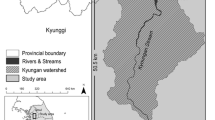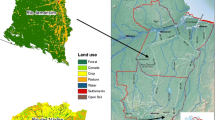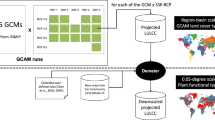Abstract
In order to conduct research at required spatial resolution, we propose a model fusion involving interlinked calculations of regional projections by the global dynamic model GLOBIOM (Global Biosphere Management Model) and robust dynamic downscaling model, based on cross-entropy principle, for deriving spatially resolved projections. The proposed procedure allows incorporating data from satellite images, statistics, expert opinions, as well as data from global land use models. In numerous case studies in China and Ukraine, the approach allowed to estimate local land use and land use change projections corresponding to real trends and expectations. The disaggregated data and projections were used in national models for planning sustainable land use and agricultural development.
Similar content being viewed by others
References
P. Havlík, U. Schneider, E. Schmid, H. Bottcher, S. Fritz, R. Skalsky, K. Aoki, S. De Cara, G. Kindermann, F. Kraxner, S. Leduc, I. McCallum, A. Msonier, T. Sauer, and M. Obersteiner, “Global land-use implications of first and second generation biofuel targets,” Energy Policy, Vol. 39, 5690–5702 (2011).
Y. M. Ermoliev, T. Y. Ermolieva, P. Havlík, A. Mosnier, D. Leclere, S. Fritz, M. Obersteiner, S. V. Kyryzyuk, and O. M. Borodina, “Robust downscaling approaches to disaggregation of data and projections under uncertainties: Case of land cover and land use change systems,” Cybern. Syst. Analysis, Vol. 53, No. 1, 26–33 (2017).
R. Moss, J. Edmonds, K. Hibbard, M. Manning, S. Rose, D. van Vuuren, T. Carter, S. Emori, M. Kainuma, T. Kram, G. Meehl, J. Mitchell, N. Nakicenovic, K. Riahi, S. Smith, R. Stouffer, A. Thomson, J. Weyant, and T. Wilbanks, “The next generation of scenarios for climate change research and assessment,” Nature, Vol. 463, 747–756 (2010).
X. Zhang, T. Ermolieva, J. Balkovic, A. Mosnier, F. Kraxner, and J. Liu, “Recursive cross-entropy model for spatially explicit future land uses: A case study of the Heihe river basin,” J. of Physics and Chemistry of the Earth, Vol. 89, 56–64 (2015).
R. C. Izaurralde, J. R. Williams, W. B. McGill, N. J. Rosenberg, and M. C. Q. Jakas, “Simulating soil C dynamics with EPIC: Model description and testing against long-term data,” Ecological Modeling, Vol. 192, 362–384 (2006).
G. Fischer, H. T. van Velthuizen, M. M. Shah, and F. O. Nachtergaele, “Global agro-ecological assessment for agriculture in the 21st century: Methodology and results,” Research Report RR-02-02, International Institute for Applied Systems Analysis, Laxenburg, Austria (2002).
J. Kullback, Information Theory and Statistics, John Wiley and Sons, New York (1959).
R. Skalský, Z. Tarasovičová, J. Balkovič, E. Schmid, M. Fuchs, E. Moltchanova, G. Kindermann, and P. Scholtz, Geo-Bene Global Database for Bio-Physical Modeling, v.1.0. Concepts, Methodologies and Data, Technical Report, IIASA, Laxenburg (2008).
C. Monfreda, N. Ramankutty, and J. Foley, “Farming the planet: Geographic distribution of crop areas, yields, physiological types, and net primary production in the year 2000,” Global Biogeochemical Cycles, Vol. 22, DOI:10.1029/2007GB002947 (2008).
G. E. Kindermann, I. McCallum, S. Fritz, and M. Obersteiner, “A global forest growing stock, biomass and carbon map based on FAO statistics,” Silva Fennica, Vol. 42, 387–396 (2008).
S. Leduc, D. Schwab, E. Dotzauer, E. Schmid, and M. Obersteiner, “Optimal location of wood gasification plants for methanol production with heat recovery,” Intern. J. of Energy Research, Vol. 32, 1080–1091 (2008).
O. Fricko, P. Havlik, J. Rogelj, Z. Klimont, M. Gusti, N. Johnson, P. Kolp, M. Strubegger, H. Valin, M. Amann, T. Ermolieva, N. Forsell, M. Herrero, C. Heyes, G. Kindermann, V. Krey, D. McCollum, M. Obersteiner, S. Pachauri, S. Rao, E. Schmid, W. Schopp, and K. Riahi, The marker quantification of the Shared Socioeconomic Pathway 2: A middle-of-the-road scenario for the 21st century. Global Environmental Change (2016). DOI: 10.1016/j.gloenvcha.2016.06.004.
Y. Chen, D. Zhang, Y. Sun, X. Liu, N. Wang, and H.H.G. Savenije, “Water demand management: A case study of the Heihe river basin in China,” Phys. Chem. Earth, Pt. A/B/C 30, 408–419 (2005).
S. L. Neitsch, J. G. Arnold, J. R. Kiniry, J. R. Williams, and K. W. King, “Soil and water assessment tool,” Theoretical Documentation (2002).
G. M. Foody, “Status of land cover accuracy assessment,” Remote Sens. Environ., Vol. 80, 185–201 (2002).
A. G. Zagorodny, Y. M. Ermoliev, and V. L. Bogdanov, “Integrated management, security and robustness,” Publ. by Committee for Systems Analysis and Presidium of the National Academy of Sciences of Ukraine, National Member Organization of the International Institute for Applied Systems Analysis (IIASA), Kyiv (2014).
A. N. Golodnikov, Y. M. Ermoliev, T. Y. Ermolieva, P. S. Knopov, and V. A. Pepelyaev, “Integrated modeling of food security management in Ukraine. Models for structural optimization of agricultural production under risk,” Cybern. Syst. Analysis, Vol. 49, No. 2, 217–228 (2013).
O. Borodina, E. Borodina, T. Ermolieva, Y. Ermoliev, G. Fischer, M. Makowski, and H. T. van Velthuizen, Sustainable Agriculture, Food Security, and Socio-Economic Risks in Ukraine, Springer-Verlag, Heidelberg (2012), pp. 169–185.
Y. Ermoliev, T. Ermolieva, P. Havlík, A. Mosnier, D. Leclere, M. Obersteiner, and Y. Kostyuchenko, “Estimating local-global dependencies of land use systems by downscaling from GLOBIOM model,” Publ. by Committee for Systems Analysis and Presidium of the National Academy of Sciences of Ukraine, National Member Organization of the International Institute for Applied Systems Analysis (IIASA), Kyiv (2014), pp. 228–240.
Author information
Authors and Affiliations
Corresponding author
Additional information
*The studies are carried out within the framework of the projects ECONADAPT (603906), TRANSMANGO (613532), SIGMA (603719), and AGRICISTRADE (612755) EU FP7, as well as the scientific project on the development of innovative methodologies and applications that investigate robust solutions for long-term concerted planning of food security and energy and water supply conducted jointly by the International Institute for Applied Systems Analysis (Laxenburg, Austria) and National Academy of Sciences of Ukraine.
Translated from Kibernetika i Sistemnyi Analiz, No. 2, March–April, 2017, pp. 16–29.
Rights and permissions
About this article
Cite this article
Ermolieva, T.Y., Ermoliev, Y.M., Havlík, P. et al. Dynamic Merge of the Global and Local Models for Sustainable Land Use Planning with Regard for Global Projections from GLOBIOM and Local Technical–Economic Feasibility and Resource Constraints* . Cybern Syst Anal 53, 176–185 (2017). https://doi.org/10.1007/s10559-017-9917-7
Received:
Published:
Issue Date:
DOI: https://doi.org/10.1007/s10559-017-9917-7




